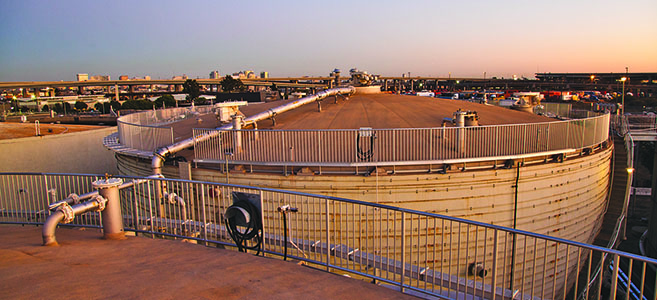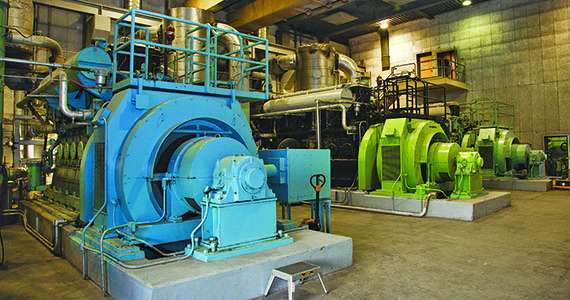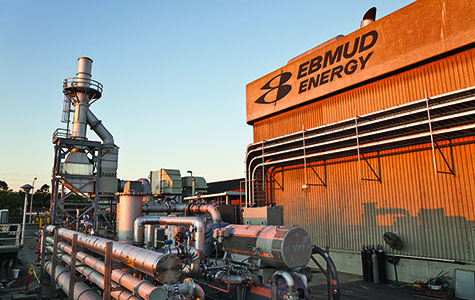The Port of Oakland recently pledged that by the year 2018, 75 percent of the energy it provides to its tenants will be derived from renewable sources.

Anaerobic digesters like these keep food scraps out of landfills, where they break down slowly and emit climate-changing gases. Food scraps from restaurants and markets are the largest single source of municipal solid waste sent to landfills. Photo courtesy of East Bay Municipal Utilities District
By Bill Picture
Published: December, 2015
The Port of Oakland recently pledged that by the year 2018, 75 percent of the energy it provides to its tenants will be derived from renewable sources.
Although you might be surprised to learn that the Port of Oakland is in the energy business, the port actually functions as its own municipal utility district, selling power purchased from the East Bay Municipal Utility District (EBMUD) to the businesses that operate on port property.
“Airport, seaport and commercial real estate are our three official revenue divisions,” explains Port spokesman Robert Bernardo. “But lately we’ve been saying that we really have four lines of business—the fourth being as an energy provider to our tenants.”
A few years ago, the Port of Oakland struck up a partnership with EBMUD that enables the port to act as a middleman, purchasing electricity from EBMUD that it can resell to port tenants. Although the port does not yet provide power to all of the properties within its geographic boundaries, 50 percent of the electricity that it does sell is already being derived from renewable sources.
Renewable energy credits offered by the state make it possible for the port to resell the electricity to its tenants at the same price it pays for it. “We don’t mark the price up at all,” said Bernardo. “It’s a really great deal for us, and great for our tenants.”
Talkin’ trash to power
Currently, 125 seaport and airport tenants purchase electricity from the Port of Oakland to power their operations. Much of that electricity comes from EBMUD’s wastewater treatment facility at the base of the Oakland span of the Bay Bridge.
While the primary job of that facility, which services more than 650,000 people in an 88-square-mile area, is treating sewage, it’s also come up with an innovative way to reduce greenhouse gases while providing a reliable and ongoing source of renewable energy. For the last seven years, EBMUD’s waste haulers have been collecting food scraps from restaurants throughout the East Bay and bringing the discarded bits to the wastewater treatment facility to be converted into clean electricity.
While most households have gotten good about composting the scraps from their home-cooked meals and gone-bad leftovers, the food discarded by restaurants and markets is still the number one form of municipal solid waste being sent to landfills.
In landfills, these perishable items break down slowly and create methane, a potent greenhouse gas that is proven to be a contributor to climate change.
With seed money from the United States Environmental Protection Agency, EMBUD began experimenting with using its “digesters,” which had previously only been used to process the solids gleaned from wastewater, to also process discarded food. Inside the digesters, special bacteria quickly break down the food, and the methane gas created during the process is captured and used to generate clean energy. Any leftover solid material is then composted for use as a natural fertilizer.
“It’s a pretty amazing process,” said Bernardo. “Literally nothing goes to waste.”
Much of the energy generated is used to power the wastewater treatment plant itself, but a decent amount of electricity is left over. Some of that leftover electricity is sold to the Port of Oakland, which also purchases solar- and wind-generated power for its tenants from SunEdison.
The EBMUD facility is currently processing 20 to 40 tons of discarded food each day. And that’s just the tip of the stinky iceberg in terms of the amount of food being discarded each day. The EPA estimates that if 50 percent of discarded food were to be fed to digesters like EBMUD’s, enough clean energy could be generated to power 2.5 million homes for an entire year. The success of EBMUD’s EPA-funded pilot program has already prompted it to plan for an expansion.
Meeting new standards
This latest move helps solidify the Port of Oakland’s reputation as one of the country’s greenest ports, and puts the port well on track to meeting new state-mandated deadlines for renewable energy.
California Senate Bill 350, the Clean Energy and Pollution Reduction Act, which was signed into law by Governor Jerry Brown in October, requires that at least 33 percent of the electricity provided to retail customers by energy providers like the port be derived from renewable sources by the end of 2020. The bill goes on to increase the minimum for renewable energy to 50 percent by the end of 2030.
“It’s important to us to meet these goals set by the state and the federal government, but it’s not necessarily what’s driving us,” said Bernardo. It’s the desire of both upper management and port tenants, he said, that pushes the port to keep looking for new ways to green its operations. “Our utilities team and director of engineering came up with this plan, and we think it will go a long way in terms of helping us to reduce our overall greenhouse gas footprint.”
“When you think about it, it just makes sense,” Bernardo said. “We’re in a unique position to be a landlord and an environmental steward, and to help our tenants. We have so many tenants, and they all need energy to do business. So it’s only logical that we should be providing that energy; and why not do that in the cleanest, greenest, most responsible and most sustainable way that we possibly can?”

The methane gas captured during the anaerobic digestion process is used to power turbines that create clean energy. The Port of Oakland has pledged that by 2018, 75 percent of the power it provided to tenants will be from renewable sources like this one. Photo courtesy of East Bay Municipal Utilities District

The Port of Oakland acts as its own municipal utility district providing power to tenants. Much of that electricity is purchased from East Bay Municipal Utility District and resold without a markup. Photo courtesy of East Bay Municipal Utilities District

